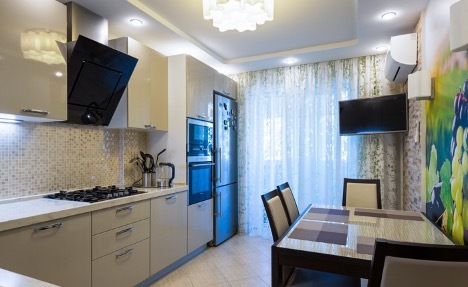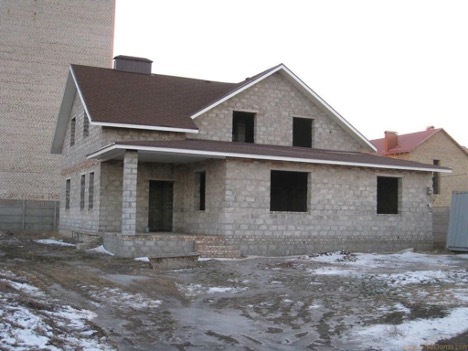It is quite possible to do a kitchen renovation with your own hands. The work is carried out in several stages - first they make an estimate and think over the design, choose the right materials. Then they begin to prepare the premises, perform a rough finish, put windows and doors. The last stages are associated with finishing, creating an apron and summing up communications. Each step is detailed in the instructions below.
The content of the article
-
Preparation and selection of materials
- Floor materials
- Wall materials
- Ceiling materials
-
Repair instructions
- Rough finish
- Installation of windows and doors
- Finishing
- Apron finish
Preparation and selection of materials
Before you understand how to make repairs in the kitchen, you need to make a plan, as well as decide on finishing materials. To make the result look beautiful, and at the same time the estimate was not too expensive, it is necessary to decide on the materials for finishing the floor, walls and ceiling.
Floor materials
Ideas for renovating a kitchen involve choosing the right materials. In the case of the floor, you can consider the following options:
- Ceramic tile - it is difficult to lay, the thermal insulation is low. However, it is very resistant to stress and pollution. In addition, today they produce many varieties of tiles, including those with imitation for certain materials, for example, wood.
- Linoleum affordable and easy to install, resistant to liquids, fats. However, it may be hit by a sharp object, such as a knife being dropped.
- Another way to make repairs in the kitchen with your own hands - create cork cover. Eco-friendly and warm material, provides a pleasant walking experience. However, it can suffer from pollution and is not very durable.
- Laminate – durable, easy to install, resistant to any liquids and dirt. This is a good option, how beautiful it is to make repairs in the kitchen. At the same time, it does not provide complete tightness - spilled water through the joints can get onto the substrate.
- Parquet, parquet board - very strong and reliable, but cannot serve for a long time due to the negative effects of humidity and spilled liquids. It is better not to use such material in the kitchen.

Wall materials
When choosing materials for wall decoration, you can consider such ideas for do-it-yourself kitchen renovation:
- Washable wallpapers - have a protective film that protects them from liquids and grease.
- Paint is the most budget option, affordable and at the same time giving a beautiful result. For the kitchen, it is recommended to use semi-gloss compositions.
- Decorative plasters - such materials for kitchen renovation are suitable if the walls have large irregularities. Plaster allows you to get a flat surface that can, for example, be painted or wallpapered.
- Ceramic tiles - as a rule, are used only to create aprons.
Ceiling materials
It is necessary to make repairs in the kitchen with your own hands in stages, choosing materials for all surfaces, including the ceiling. Here are the possible options:
- Suspended ceiling made of moisture-resistant plasterboard or plastic panels. It is resistant to moisture and fats, does not require special care. But it occupies a certain space, due to which the ceiling height is reduced by 10-15 cm.
- Stretch ceiling takes up a minimum of space and is inexpensive. This is the main way to repair a kitchen with your own hands cheaply, but keep in mind that such a surface can be hit by any sharp object.
- Finally, there is an affordable way to finish the ceiling with Styrofoam or Styrofoam tiles. By choosing laminated tiles, you can get a beautiful surface, which is also not afraid of moisture.

Repair instructions
The budget option for do-it-yourself repairs in the kitchen, the photo of which is shown below, involves a rough finish, installation of windows and doors, after which the finishing and apron are done. The main steps are described below.
Rough finish
At the first stage, they act like this:
- They free the kitchen from furniture, engineering networks, including electrical wiring.

- Carry out rough work to level the ceiling, floor, wall surface. Remove old coatings first.

- Install new water meters (if necessary), connect the heating system.
- Replace old metal pipes with new polypropylene or metal-plastic pipes (they are more durable).
- To understand how to renovate the kitchen, it is important to outline the points of supply of electricity. After that, new wiring is laid.
- Align the ceiling with plaster and form a frame for installing drywall or stretch PVC sheets. You can also prepare the surface for gluing ceiling tiles.

- Do-it-yourself budget repairs in the kitchen also involve finishing the walls with plaster mixtures. After they are completely dry, the surfaces are thoroughly cleaned.

- Next, the floor is leveled, a concrete screed is laid or the boards are strengthened, and fiberboard is covered on top.

Installation of windows and doors
New windows and doors can be installed as needed. If the kitchen already has PVC and a high-quality window sill has been made, you can only replace the doorway and the canvas, since the old doors will clearly spoil the impression.
You can choose designs from different materials - traditional and modern:
- tree;
- Chipboard;
- plastic.
By type, it can be a classic swing door or a sliding door, as in a closet. To save space, they often make a folding accordion, which looks more original.
Finishing
After the repair of the walls in the kitchen in the rough version is completed, it's time to start finishing. For this, appropriate materials are used, for example, expanded polystyrene tiles for the ceiling, wallpaper for the walls and laminate flooring. Previously, the walls are primed and decorative plaster is applied. Instead, you can whiten or immediately start wallpapering.

Apron finish
Repair in the kitchen with your own hands, the photo of which is ostentatious above, also involves the creation of an apron. To do this, you can use different materials:
- Ceramic tile – durable, easy to clean and resistant to dirt. It looks beautiful if the elements are small, for example, in the form of squares 10 * 10 cm.
- Glass - it is well laundered, allows you to create a beautiful backlight. But it can be fragile, so it is better to choose hardened materials. In any case, the glass is fragile, so you need to handle such an apron with care.
- MDF – modern panels that are easy to clean from dirt. A definite plus is a wide range of colors that can be selected in accordance with the design of the room.
After finishing and installing the apron, they mount the sink, faucets, put the hood, faucets and sockets. Purchase new furniture and hang it on pre-installed hinges. at the same time, it is important to focus on the conformity of the design so that the room looks stylish and spectacular.


